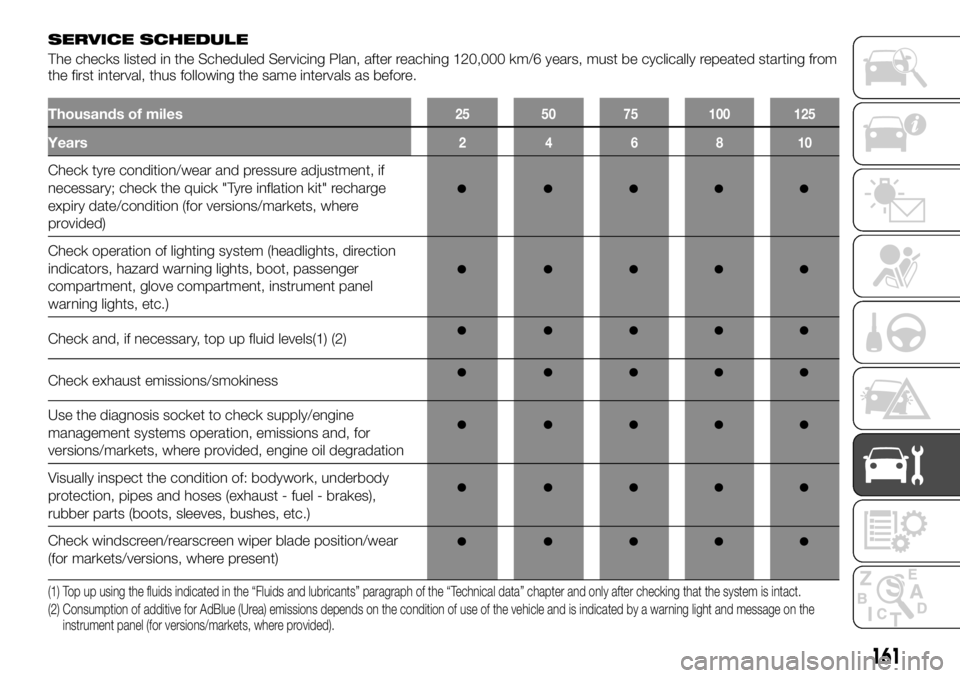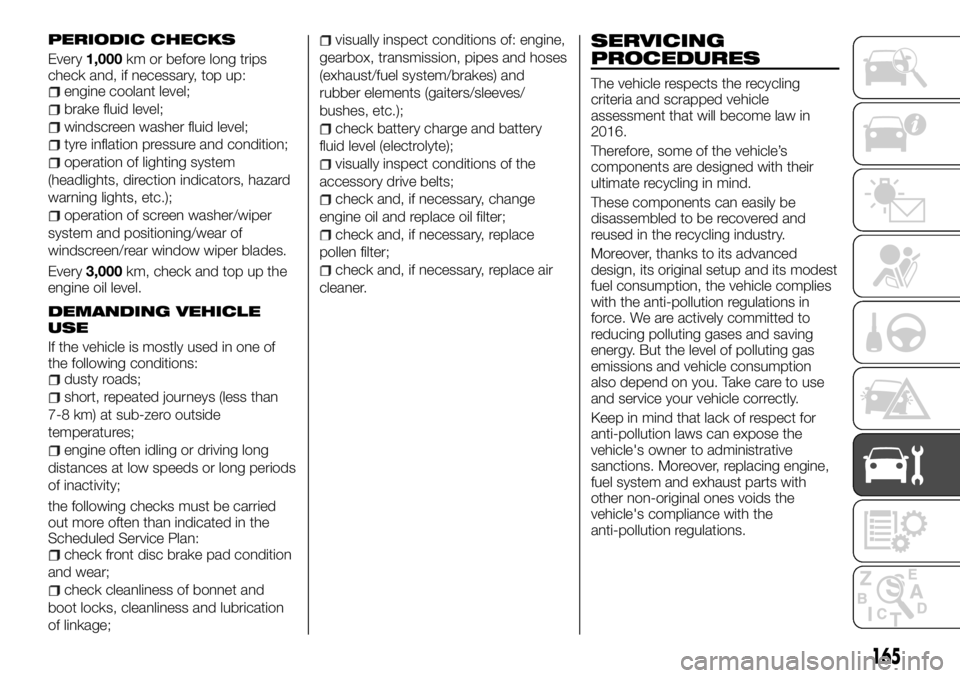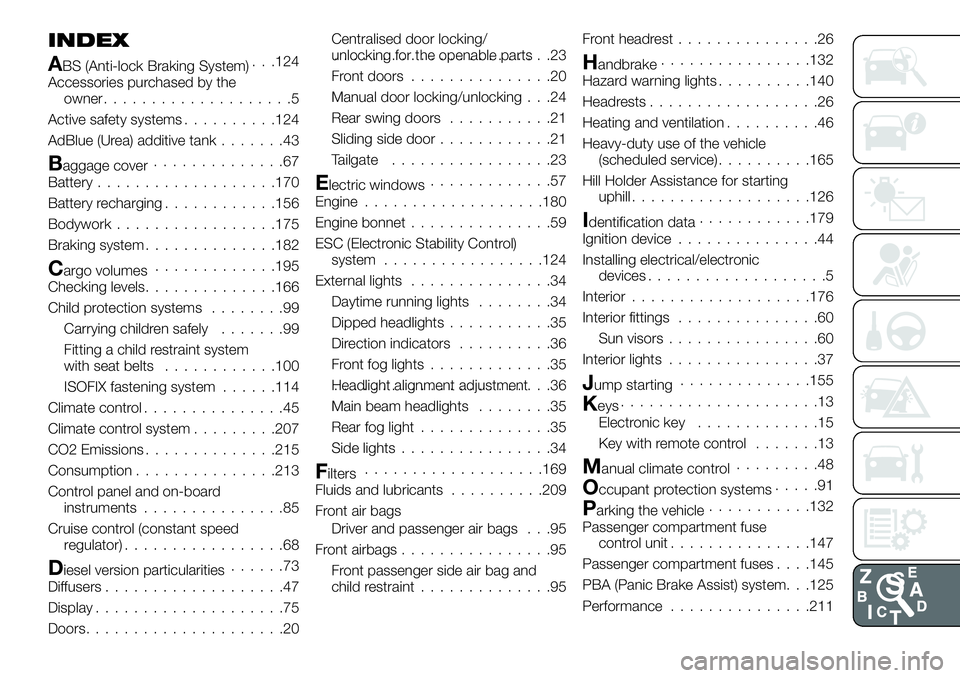service indicator FIAT TALENTO 2018 Owner handbook (in English)
[x] Cancel search | Manufacturer: FIAT, Model Year: 2018, Model line: TALENTO, Model: FIAT TALENTO 2018Pages: 232, PDF Size: 5.54 MB
Page 163 of 232

Thousands of miles25 50 75 100 125
SERVICE SCHEDULE
The checks listed in the Scheduled Servicing Plan, after reaching 120,000 km/6 years, must be cyclically repeated starting from
the first interval, thus following the same intervals as before.
Years246810
Check tyre condition/wear and pressure adjustment, if
necessary; check the quick "Tyre inflation kit" recharge
expiry date/condition (for versions/markets, where
provided)
Check operation of lighting system (headlights, direction
indicators, hazard warning lights, boot, passenger
compartment, glove compartment, instrument panel
warning lights, etc.)
Check and, if necessary, top up fluid levels(1) (2)
Check exhaust emissions/smokiness
Use the diagnosis socket to check supply/engine
management systems operation, emissions and, for
versions/markets, where provided, engine oil degradation
Visually inspect the condition of: bodywork, underbody
protection, pipes and hoses (exhaust - fuel - brakes),
rubber parts (boots, sleeves, bushes, etc.)
Check windscreen/rearscreen wiper blade position/wear
(for markets/versions, where present)
(1) Top up using the fluids indicated in the “Fluids and lubricants” paragraph of the “Technical data” chapter and only after checking that the system is intact.
(2) Consumption of additive for AdBlue (Urea) emissions depends on the condition of use of the vehicle and is indicated by a warning light and message onthe
instrument panel (for versions/markets, where provided).
161
Page 167 of 232

PERIODIC CHECKS
Every1,000km or before long trips
check and, if necessary, top up:
engine coolant level;
brake fluid level;
windscreen washer fluid level;
tyre inflation pressure and condition;
operation of lighting system
(headlights, direction indicators, hazard
warning lights, etc.);
operation of screen washer/wiper
system and positioning/wear of
windscreen/rear window wiper blades.
Every3,000km, check and top up the
engine oil level.
DEMANDING VEHICLE
USE
If the vehicle is mostly used in one of
the following conditions:
dusty roads;
short, repeated journeys (less than
7-8 km) at sub-zero outside
temperatures;
engine often idling or driving long
distances at low speeds or long periods
of inactivity;
the following checks must be carried
out more often than indicated in the
Scheduled Service Plan:
check front disc brake pad condition
and wear;
check cleanliness of bonnet and
boot locks, cleanliness and lubrication
of linkage;
visually inspect conditions of: engine,
gearbox, transmission, pipes and hoses
(exhaust/fuel system/brakes) and
rubber elements (gaiters/sleeves/
bushes, etc.);
check battery charge and battery
fluid level (electrolyte);
visually inspect conditions of the
accessory drive belts;
check and, if necessary, change
engine oil and replace oil filter;
check and, if necessary, replace
pollen filter;
check and, if necessary, replace air
cleaner.
SERVICING
PROCEDURES
The vehicle respects the recycling
criteria and scrapped vehicle
assessment that will become law in
2016.
Therefore, some of the vehicle’s
components are designed with their
ultimate recycling in mind.
These components can easily be
disassembled to be recovered and
reused in the recycling industry.
Moreover, thanks to its advanced
design, its original setup and its modest
fuel consumption, the vehicle complies
with the anti-pollution regulations in
force. We are actively committed to
reducing polluting gases and saving
energy. But the level of polluting gas
emissions and vehicle consumption
also depend on you. Take care to use
and service your vehicle correctly.
Keep in mind that lack of respect for
anti-pollution laws can expose the
vehicle's owner to administrative
sanctions. Moreover, replacing engine,
fuel system and exhaust parts with
other non-original ones voids the
vehicle's compliance with the
anti-pollution regulations.
165
Page 229 of 232

INDEX
ABS (Anti-lock Braking System). . .124
Accessories purchased by the
owner....................5
Active safety systems..........124
AdBlue (Urea) additive tank.......43
Baggage cover..............67
Battery...................170
Battery recharging............156
Bodywork.................175
Braking system..............182
Cargo volumes.............195
Checking levels..............166
Child protection systems........99
Carrying children safely.......99
Fitting a child restraint system
with seat belts............100
ISOFIX fastening system......114
Climate control...............45
Climate control system.........207
CO2 Emissions..............215
Consumption...............213
Control panel and on-board
instruments...............85
Cruise control (constant speed
regulator).................68
Diesel version particularities......73
Diffusers...................47
Display....................75
Doors.....................20Centralised door locking/
unlocking for the openable parts.......................23
Front doors...............20
Manual door locking/unlocking . . .24
Rear swing doors...........21
Sliding side door............21
Tailgate.................23
Electric windows.............57
Engine...................180
Engine bonnet...............59
ESC (Electronic Stability Control)
system.................124
External lights...............34
Daytime running lights........34
Dipped headlights...........35
Direction indicators..........36
Front fog lights.............35
Headlight alignment adjustment.......................36
Main beam headlights........35
Rear fog light..............35
Side lights................34
Filters...................169
Fluids and lubricants..........209
Front air bags
Driver and passenger air bags . . .95
Front airbags................95
Front passenger side air bag and
child restraint..............95Front headrest...............26
Handbrake................132
Hazard warning lights..........140
Headrests..................26
Heating and ventilation..........46
Heavy-duty use of the vehicle
(scheduled service)..........165
Hill Holder Assistance for starting
uphill...................126
Identification data............179
Ignition device...............44
Installing electrical/electronic
devices...................5
Interior...................176
Interior fittings...............60
Sun visors................60
Interior lights................37
Jump starting..............155
Keys.....................13
Electronic key.............15
Key with remote control.......13
Manual climate control.........48
Occupant protection systems.....91
Parking the vehicle...........132
Passenger compartment fuse
control unit...............147
Passenger compartment fuses. . . .145
PBA (Panic Brake Assist) system. . .125
Performance...............211